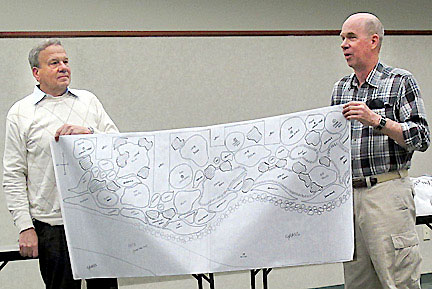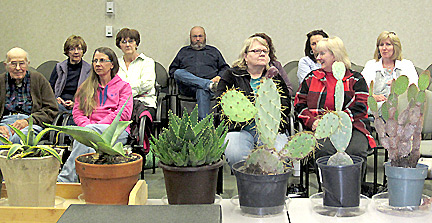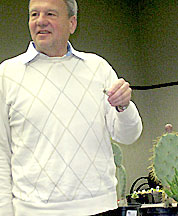
Holding up a diagram of the proposed succulent garden for the south side of the Springfield Botanical Center are (L-R) Dean Kinzer, club member and consummate succulent collector, and Paul Robertson, president of the Succulent Society of the Ozarks.
"Science fiction movies," was the response speaker Dean Kinzer gave for how he got interested in collecting succulent plants. Kinzer was addressing members of the Succulent Society of the Ozarks at a meeting held on April 15, 2014, at the Library Center in Springfield.
Calling his interest in succulents "a little goofy," Kinzer said that movies in which plant spores subject to radiation created monster plants caught his attention. "I like plants that are tough," he repeated a couple of times.

A large assortment of cacti and succulents line a table during the April 2014 meeting of the Succulent Society of the Ozarks. They included a climbing onion (not an onion), a pregnant onion (also a lily), pencil cactus (not a cactus), kalanchoe (a long flowering succulent sensitive to cold), stapelia (characterized by large smelly flowers) and blue agave (from which tequila is made from liquid in stem).
Admitting he was a bachelor, the former Chicago resident said a "better half wouldn't put up with his 'hobby.'" Collecting plants--succulents and cacti--might seem innocent enough. However, Kinzer said he's filled a spare bedroom with his plants, his dining room table and much of his basement.
The topic of his talk dealt with the migration of his plants from the inside to the outside (hoping to avoid an immediate reversal should he have miscalculated the weather and experienced a frost).
"Cacti don't cover real well," Kinzer said.
 Speaker Kinzer holds a "baby" he carefully plucked from one of his succulents. Speaker Kinzer holds a "baby" he carefully plucked from one of his succulents.
After buying a picnic table to use as a template, Kinzer said he bought lumber and made his own. Creating and filling the tops of these tables is the part of the migration process Kinzer says he loves.
While he migrates most of his plants to the outside where he lets Mother Nature water them, he did admit to owning a "few" (this may be misleading) sensitive plants that stay inside.
A look beyond the picnic tables one can see hearty yellow stripe yuccas, hens and chicks and a patch of prickly pears.
What Kinzer says he runs out of are containers as he pointed to an aloe plant with "babies" to separate out. Keeping the expense down, Kinzer said that he uses four or five bags of ordinary topsoil to one bag of Ortho time release fertilizer and lets his plants build up strength before separating them. "Gently pull away the rooted baby by loosening the dirt ball," Kinzer advised.
"What do you do with all the newly potted babies?" Paul Robertson, club president, asked, perhaps, with an ulterior motive in mind.
But "build another picnic table, I guess," was Kinzer quick response.
Succulent garden planned for Springfield Botanical Center
Peter Longley, the horticultural interpreter for the Springfield Botanical Center, was on hand to discuss modifications to plans to create a succulent garden on the south portico of the center.
Calling attention to the possibility that the location could get quite hot, Longley basically took a trial and error stance regarding the success of the garden. His modifications included conveniently placed rocks to protect area flood lights, the incorporation of nearby windows in the design and allowance for a planned adjacent tram path.
While an extensive plant list includes tropicals, yuccas, agaves, barrel cacti, euphorbia, sedums, ice plants--to name a few--even a flying dragon tree as a background specimen, the actual plants that will be used depend heavily on donations.
Longley said he needed advice for such a project as he learns what is needed, for example, how to prevent erosion or where to get rocks to incorporate into the design. And most of all, volunteers are needed to help define the area and prepare it for the plants.
Go Back | 






